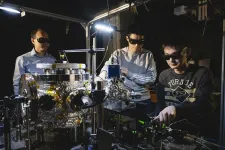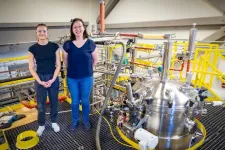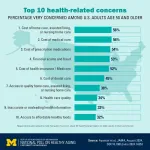(Press-News.org) Physicists at Purdue are throwing the world’s smallest disco party. The disco ball itself is a fluorescent nanodiamond, which they have levitated and spun at incredibly high speeds. The fluorescent diamond emits and scatters multicolor lights in different directions as it rotates. The party continues as they study the effects of fast rotation on the spin qubits within their system and are able to observe the Berry phase. The team, led by Tongcang Li, professor of Physics and Astronomy and Electrical and Computer Engineering at Purdue University, published their results in Nature Communications. Reviewers of the publication described this work as “arguably a groundbreaking moment for the study of rotating quantum systems and levitodynamics” and “a new milestone for the levitated optomechanics community.”
“Imagine tiny diamonds floating in an empty space or vacuum. Inside these diamonds, there are spin qubits that scientists can use to make precise measurements and explore the mysterious relationship between quantum mechanics and gravity,” explains Li, who is also a member of the Purdue Quantum Science and Engineering Institute. “In the past, experiments with these floating diamonds had trouble in preventing their loss in vacuum and reading out the spin qubits. However, in our work, we successfully levitated a diamond in a high vacuum using a special ion trap. For the first time, we could observe and control the behavior of the spin qubits inside the levitated diamond in high vacuum.”
The team made the diamonds rotate incredibly fast—up to 1.2 billion times per minute! By doing this, they were able to observe how the rotation affected the spin qubits in a unique way known as the Berry phase.
“This breakthrough helps us better understand and study the fascinating world of quantum physics,” he says.
The fluorescent nanodiamonds, with an average diameter of about 750 nm, were produced through high-pressure, high-temperature synthesis. These diamonds were irradiated with high-energy electrons to create nitrogen-vacancy color centers, which host electron spin qubits. When illuminated by a green laser, they emitted red light, which was used to read out their electron spin states. An additional infrared laser was shone at the levitated nanodiamond to monitor its rotation. Like a disco ball, as the nanodiamond rotated, the direction of the scattered infrared light changed, carrying the rotation information of the nanodiamond.
The authors of this paper were mostly from Purdue University and are members of Li’s research group: Yuanbin Jin (postdoc), Kunhong Shen (PhD student), Xingyu Gao (PhD student) and Peng Ju (recent PhD graduate). Li, Jin, Shen, and Ju conceived and designed the project and Jin and Shen built the setup. Jin subsequently performed measurements and calculations and the team collectively discussed the results. Two non-Purdue authors are Alejandro Grine, principal member of technical staff at Sandia National Laboratories, and Chong Zu, assistant professor at Washington University in St. Louis. Li’s team discussed the experiment results with Grine and Zu who provided suggestions for improvement of the experiment and manuscript.
“For the design of our integrated surface ion trap,” explains Jin, “we used a commercial software, COMSOL Multiphysics, to perform 3D simulations. We calculate the trapping position and the microwave transmittance using different parameters to optimize the design. We added extra electrodes to conveniently control the motion of a levitated diamond. And for fabrication, the surface ion trap is fabricated on a sapphire wafer using photolithography. A 300-nm-thick gold layer is deposited on the sapphire wafer to create the electrodes of the surface ion trap.”
So which way are the diamonds spinning and can they be speed or direction manipulated? Shen says yes, they can adjust the spin direction and levitation.
“We can adjust the driving voltage to change the spinning direction,” he explains. “The levitated diamond can rotate around the z-axis (which is perpendicular to the surface of the ion trap), shown in the schematic, either clockwise or counterclockwise, depending on our driving signal. If we don’t apply the driving signal, the diamond will spin omnidirectionally, like a ball of yarn.”
Levitated nanodiamonds with embedded spin qubits have been proposed for precision measurements and creating large quantum superpositions to test the limit of quantum mechanics and the quantum nature of gravity.
“General relativity and quantum mechanics are two of the most important scientific breakthroughs in the 20th century. However, we still do not know how gravity might be quantized,” says Li. “Achieving the ability to study quantum gravity experimentally would be a tremendous breakthrough. In addition, rotating diamonds with embedded spin qubits provide a platform to study the coupling between mechanical motion and quantum spins.”
This discovery could have a ripple effect in industrial applications. Li says that levitated micro and nano-scale particles in vacuum can serve as excellent accelerometers and electric field sensors. For example, the US Air Force Research Laboratory (AFRL) are using optically-levitated nanoparticles to develop solutions for critical problems in navigation and communication.
“At Purdue University, we have state-of-the-art facilities for our research in levitated optomechanics,” says Li. “We have two specialized, home-built systems dedicated to this area of study. Additionally, we have access to the shared facilities at the Birck Nanotechnology Center, which enables us to fabricate and characterize the integrated surface ion trap on campus. We are also fortunate to have talented students and postdocs capable of conducting cutting-edge research. Furthermore, my group has been working in this field for ten years, and our extensive experience has allowed us to make rapid progress.”
Quantum research is one of four key pillars of the Purdue Computes initiative, which emphasizes the university’s extensive technological and computational environment.
This research was supported by the National Science Foundation (grant number PHY-2110591), the Office of Naval Research (grant number N00014-18-1-2371), and the Gordon and Betty Moore Foundation (grant DOI 10.37807/gbmf12259). The project is also partially supported by the Laboratory Directed Research and Development program at Sandia National Laboratories.
Related News:
Purdue physicists lift a nano-dumbbell with light and spin it at 100 billion rpm near a surface: Department of Physics and Astronomy: Purdue University
Chip-based optical tweezers levitate nanoparticles in a vacuum (phys.org)
Light powers world's fastest-spinning object - Purdue University News
About the Department of Physics and Astronomy at Purdue University
Purdue’s Department of Physics and Astronomy has a rich and long history dating back to 1904. Our faculty and students are exploring nature at all length scales, from the subatomic to the macroscopic and everything in between. With an excellent and diverse community of faculty, postdocs and students who are pushing new scientific frontiers, we offer a dynamic learning environment, an inclusive research community and an engaging network of scholars.
Physics and Astronomy is one of the seven departments within the Purdue University College of Science. World-class research is performed in astrophysics, atomic and molecular optics, accelerator mass spectrometry, biophysics, condensed matter physics, quantum information science, and particle and nuclear physics. Our state-of-the-art facilities are in the Physics Building, but our researchers also engage in interdisciplinary work at Discovery Park District at Purdue, particularly the Birck Nanotechnology Center and the Bindley Bioscience Center. We also participate in global research including at the Large Hadron Collider at CERN, many national laboratories (such as Argonne National Laboratory, Brookhaven National Laboratory, Fermilab, Oak Ridge National Laboratory, the Stanford Linear Accelerator, etc.), the James Webb Space Telescope, and several observatories around the world.
About Purdue University
Purdue University is a public research institution demonstrating excellence at scale. Ranked among top 10 public universities and with two colleges in the top four in the United States, Purdue discovers and disseminates knowledge with a quality and at a scale second to none. More than 105,000 students study at Purdue across modalities and locations, including nearly 50,000 in person on the West Lafayette campus. Committed to affordability and accessibility, Purdue’s main campus has frozen tuition 13 years in a row. See how Purdue never stops in the persistent pursuit of the next giant leap — including its first comprehensive urban campus in Indianapolis, the Mitch Daniels School of Business, Purdue Computes and the One Health initiative — at https://www.purdue.edu/president/strategic-initiatives.
Contributors
Tongcang Li, Professor of Physics and Astronomy and Electrical and Computer Engineering at Purdue
Tongcang Li Research Group | Purdue University (google.com)
Writer: Cheryl Pierce, Purdue College of Science
END
Purdue physicists throw world’s smallest disco party
A new milestone has been set for levitated optomechanics as Prof. Tongcang Li’s group observed the Berry phase of electron spins in nano-sized diamonds levitated in vacuum
2024-08-14
ELSE PRESS RELEASES FROM THIS DATE:
Tropical Atlantic mixing rewrites climate pattern rules
2024-08-14
The churning of the upper ocean in the tropics of Atlantic Ocean plays a crucial role in shaping long-term climate patterns across the world, a new study has found.
Researchers have discovered that changes in the ocean's mixed layer - the topmost section where wind and waves blend warm surface waters with cooler depths - are the primary force behind a climate phenomenon known as Atlantic Multidecadal Variability (AMV) in the tropics.
The AMV has far-reaching effects on global climate. It influences weather patterns from North America to Europe and Africa, affecting everything from hurricane ...
New open access journal from APS and Sage expands publishing opportunity for psychological scientists
2024-08-14
The Association for Psychological Science (APS) and Sage announce the launch of Advances in Psychological Science Open, a fully open access journal that will publish high-quality empirical, technical, theoretical, and review articles, across the full range of areas and topics in psychological science. The journal will accept submissions in a variety of formats, including long-form articles and short reports, and APS is encouraging scientists to submit integrative and interdisciplinary research articles.
“APS is always working to identify new ways to catalyze advances in psychological science,” said APS CEO Robert Gropp. “We are excited to announce ...
iFAB Tech Hub grows net-zero industrial chemical partnerships, champions bioeconomy
2024-08-14
In the wake of the $51 million funding announcement from the Economic Development Administration, momentum is tangible for the Illinois Fermentation and Agriculture Biomanufacturing (iFAB) Tech Hub. Today marks the beginning of a new collaboration to replace fossil fuel-derived petrochemicals with zero-emission alternatives produced through precision fermentation.
Industrial Microbes (iMicrobes) is partnering with the iFAB Tech Hub’s Integrated Bioprocessing Research Laboratory at the University of Illinois Urbana-Champaign to harness microbes to produce acrylic acid, a versatile chemical ...
Fracking frenzy in India: A water crisis in the making?
2024-08-14
India's plans to scale up fracking operations without robust regulations could spell disaster for the country's finely balanced water security, according to research from the University of Surrey.
India is positioning shale gas as a key transitional energy source and has announced 56 fracking projects across six states. Despite the promise of energy independence, Surrey’s study raises alarm bells about the country's preparedness to handle the unique water risks posed by fracking.
Hydraulic fracturing, or fracking, involves injecting high-pressure fluid into shale ...
New research identifies early sensorimotor markers for autism spectrum disorder
2024-08-14
New York, August 14 2024 – A study published in the journal iSCIENCE has uncovered significant findings related to the early sensorimotor features and cognitive abilities of toddlers who are later diagnosed with Autism Spectrum Disorder (ASD). The research, led by Kristina Denisova, a professor of Psychology and Neuroscience at the CUNY Graduate Center and Queens College, takes an important step toward better understanding ASD so that more precise, individually tailored interventions can be developed.
Autism Spectrum Disorder, typically diagnosed around the ages of 4 to ...
Mutation detection of phosphatidylinositol-4,5-bisphosphate 3-kinase catalytic subunit alpha for treatment guidance in breast cancer
2024-08-14
Breast cancer remains a significant health concern worldwide, with diverse molecular subtypes that necessitate personalized therapeutic approaches. Recent advances have highlighted the importance of molecular signatures in guiding breast cancer treatment. Among these, the phosphatidylinositol-4,5-bisphosphate 3-kinase catalytic subunit alpha (PIK3CA) gene mutation has emerged as a crucial factor in determining the efficacy of targeted therapies, particularly in advanced breast cancer. This review explores the role of PIK3CA mutation detection in breast cancer and its implications for personalized treatment strategies.
Breast Cancer Heterogeneity
Breast ...
State COVID-19 vaccine mandates and uptake among health care workers in the US
2024-08-14
About The Study: This repeated cross-sectional study found that state COVID-19 vaccine mandates for health care workers (HCWs) were associated with increased vaccine uptake among HCWs, especially among younger HCWs and those in states with no test-out option. These findings suggest the potential for vaccine mandates to further promote vaccinations in an already highly vaccinated HCW population, especially when no test-out option is in place.
Corresponding Author: To contact the corresponding author, Charles Stoecker, ...
Depressive symptoms in adolescence and young adulthood
2024-08-14
About The Study: This panel cohort study found that increases in depressive symptoms in adolescence persisted into young adulthood, suggesting the need for primary prevention and mental health resources during the adolescent years.
Corresponding Author: To contact the corresponding author, Katherine M. Keyes, PhD, email kmk2104@columbia.edu.
To access the embargoed study: Visit our For The Media website at this link https://media.jamanetwork.com/
(doi:10.1001/jamanetworkopen.2024.27748)
Editor’s Note: Please see the ...
Leading health-related concerns of older adults before the 2024 election
2024-08-14
About The Study: In this nationally representative survey regarding 26 prominent health-related issues, older adults reported being most concerned about costs of health care and health insurance for older adults in their community, as well as financial scams and fraud. More than half of older adults in nearly all demographic groups reported being very concerned about the costs of medical care and prescription drugs, with significant differences by gender and political ideology. Women reported being more concerned than men, and liberal and moderate individuals more concerned than conservative ...
As election approaches, national poll shows which health topics concern older adults most
2024-08-14
More than half of the people who voted in the 2020 election were age 50 and older, making this age group a key demographic for candidates up and down the ballot.
Now, a new study shows what issues top their lists of health-related concerns going into this November’s election.
Five of the top six issues that the highest percentage of older adults reported being very concerned about have to do with the cost of different kinds of health care, from medical care and prescription drugs to long-term care, health insurance ...
LAST 30 PRESS RELEASES:
Air pollution exposure and birth weight
Obstructive sleep apnea risk and mental health conditions among older adults
How talking slows eye movements behind the wheel
The Ceramic Society of Japan’s Oxoate Ceramics Research Association launches new international book project
Heart-brain connection: international study reveals the role of the vagus nerve in keeping the heart young
Researchers identify Rb1 as a predictive biomarker for a new therapeutic strategy in some breast cancers
Survey reveals ethical gaps slowing AI adoption in pediatric surgery
Stimulant ADHD medications work differently than thought
AI overestimates how smart people are, according to HSE economists
HSE researchers create genome-wide map of quadruplexes
Scientists boost cell "powerhouses" to burn more calories
Automatic label checking: The missing step in making reliable medical AI
Low daily alcohol intake linked to 50% heightened mouth cancer risk in India
American Meteorological Society announces Rick Spinrad as 2026 President-Elect
Biomass-based carbon capture spotlighted in newly released global climate webinar recording
Illuminating invisible nano pollutants: advanced bioimaging tracks the full journey of emerging nanoscale contaminants in living systems
How does age affect recovery from spinal cord injury?
Novel AI tool offers prognosis for patients with head and neck cancer
Fathers’ microplastic exposure tied to their children’s metabolic problems
Research validates laboratory model for studying high-grade serous ovarian cancer
SIR 2026 delivers transformative breakthroughs in minimally invasive medicine to improve patient care
Stem Cell Reports most downloaded papers of 2025 highlight the breadth and impact of stem cell research
Oxford-led study estimates NHS spends around 3% of its primary and secondary care budget on the health impacts of heat and cold in England
A researcher’s long quest leads to a smart composite breakthrough
Urban wild bees act as “microbial sensors” of city health.
New study finds where you live affects recovery after a hip fracture
Forecasting the impact of fully automated vehicle adoption on US road traffic injuries
Alcohol-related hospitalizations from 2016 to 2022
Semaglutide and hospitalizations in patients with obesity and established cardiovascular disease
Researchers ‘listen in’ to embryo-mother interactions during implantation using a culture system replicating the womb lining
[Press-News.org] Purdue physicists throw world’s smallest disco partyA new milestone has been set for levitated optomechanics as Prof. Tongcang Li’s group observed the Berry phase of electron spins in nano-sized diamonds levitated in vacuum


